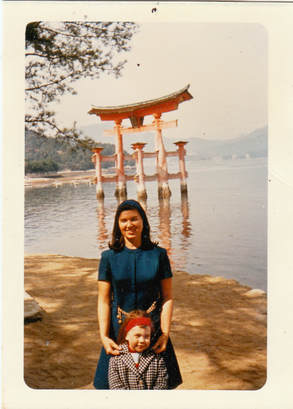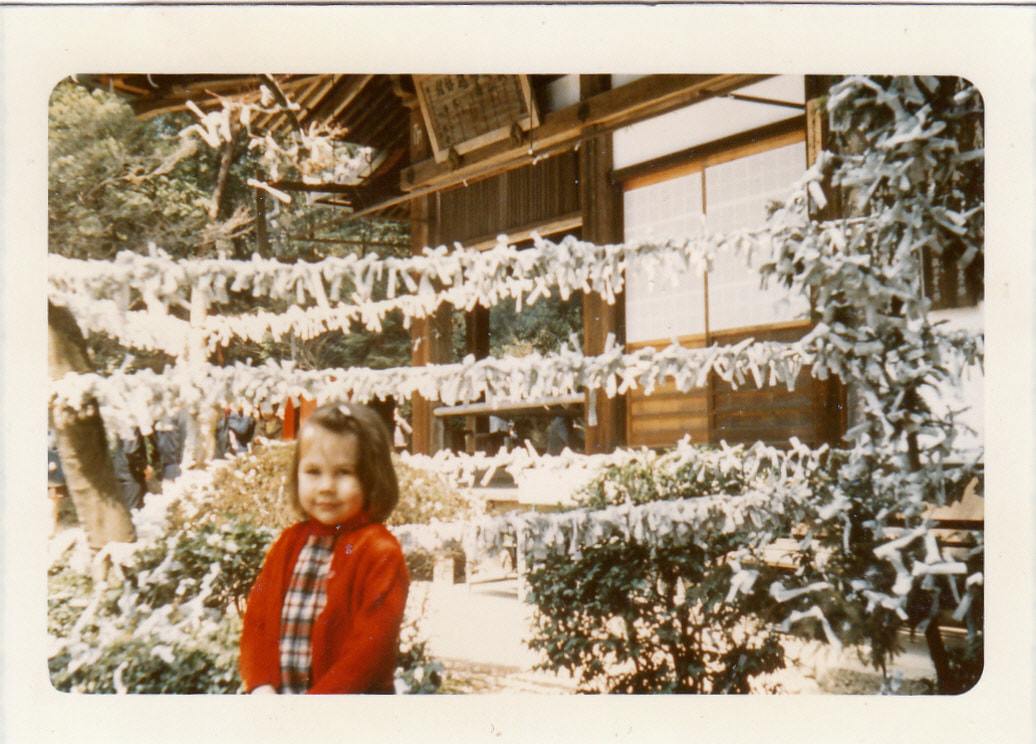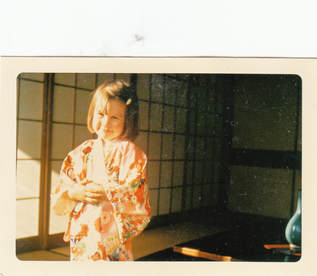
We agreed that we couldn't miss Expo 70, a new world's fair just two years after our first. Plus, it was a wonderful excuse to see Japan—but how would we do it? It would be our first trip to a part of the world we knew little about. One of Sherrill's clippings had the answer: the Japan Travel Bureau in San Francisco. They put together a tour for us so we could travel independently, but with their help. During the weeks we were there, an agent magically appeared at each stop, to get us on or off a train, take us to or from a hotel, guide us at a site.
When our Japan Air flight stopped in Anchorage for refueling, we had time to walk around a bit, despite patches of snow on the ground, and to buy four and a half year-old Simone an Eskimo doll. By the time we reached our hotel in Tokyo, we were tired and hungry. Simone was in the best shape because she'd slept the most on the plane. We rested a while and then made our way to a restaurant in the hotel. Most of the dishes on the menu were illustrated with color photographs, as we soon discovered is typical in Japan. Some restaurants even had displays of plastic copies of the different dishes. However, we didn't see much that looked familiar. We ordered ice cream for Simone and then pointed to a photograph of something that maybe we'd seen before. It turned out to be steak tartar, not what we'd expected. With a flourish, the young waitress cracked an egg over the raw beef, then exploded in shy giggles: a double yolk! A sign of good luck, she told us. Good. We had a feeling we'd need it.
"Here comes the Bullet Train," someone called as we waited on the platform for our train at Tokyo's Asakusa Station the next morning.
Simultaneously, everyone on the platform turned to look, but it shot past without stopping in such a blur, that we could only laugh. Then, a little later, by train and bus, we climbed to the great mountain shrine of Nikko, where we found scattered patches of snow like sugar dusting the rocks and gravel around the ornately carved temples and pagodas. We let Simone play in it for a while, since that was only the second time she'd encountered snow. There wasn't much of it, but it was real. She also was delighted by the evocative, humorous carving of the Three Wise Monkeys at Nikko.
"Hear no evil, see no evil, speak no evil" they warned us.
As the days swept us along, we visited tall Japanese castles like frosted white wedding cakes, massive statues of Buddha that astonished us with their rotund beauty, peaceful lakes surrounded by pine forests, and hot springs pushing up from the volcanic turmoil under the island. A display of Japanese wedding kimonos impressed Simone so much that before we left Japan we shipped home a Japanese wedding doll in just such a splendid kimono. Meanwhile, we bought her a blossom-covered kimono just her size.
In a park next to one of the shrines, Simone gave a coin to one of the priests and then chose an o-mikuji paper fortune from a box. Our local guide read it, explained that it was a small blessing for a small person, and then attached it to one of the fat little pine trees that already were dressed in hundreds of white papers.
At last, early one morning, we boarded the famous 125 m.p.h. Bullet Train, then the fastest train in the world. On the way to the city of Nagoya we glimpsed a brief, misty view of Mt. Fuji's delicate peak. A mix of ancient and super-modern, Nagoya surprised us. At first, the white bulk of the huge castle on its hill, rebuilt after 1945, seemed to dominate the city, but much of the city also was commercial and industrial. The neon signs of Japanese characters along the streets were beautiful, but we were glad that when it mattered we had Japan Travel's agents to help us. On our own at lunch time, we explored an underground city of stores, restaurants, small shops, and cafes, one of which we stepped into at random—an informal place in which local workers were eating. A pair of them came over to our table to help us order from the photographs on the menu and to show us—especially Simone—how to use chopsticks.
In Japan, the Easter Bunny brings white eggs? The evening we arrived in the ancient capital of Kyoto, Sherrill reminded me that the next day was Easter. We couldn't let Simone think that the Easter Bunny forgot her. After dinner, I left Simone and Sherrill in the hotel and went out hunting. Candy was easy to find. Street corner peddlers, I discovered, sold cooked eggs—uncolored but at least hardboiled. I filled my pockets with them and snuck them into our room. While Simone was asleep we hid the eggs. The next morning, she found them all, including one stuck in the bathtub drain. When she was surprised by their lack of color, we explained that was the way the Japanese liked them. How odd, said her expression, but okay.
A busy Easter day in Kyoto took us to the glittering Golden Pavilion, the old Imperial Palace, Buddhist temples, and Shinto shrines. The next day, we rode a bus into the mountains to Nara, an even older city, where we visited many exquisite temples and shrines, plus the largest temple in the country, clouds of cherry blossoms floating above our heads and snow crunching beneath our feet the whole time. Then we strolled in the deer park, where Simone fed crackers to the friendly deer. Later, when we walked around in the hotel and went to dinner, she wore her new kimono. Several times, Japanese ladies stopped us to adjust the kimono and retie the belt. Apparently, they were charmed by this little girl in her flowery kimono. The same thing happened whenever she wore it during the rest of trip. To their eyes it always was tied wrong until they fixed it.
The next day took us to both Hiroshima and Nagasaki, where the atomic bombs were dropped in 1945, a very different and sobering experience. Sherrill and I took turns in the museums. Simone was too young to understand what she would have seen in them. Between the two cities, we rode a ferry to Miyajima—the Island of the gods—to see the shrine, a UNESCO World Heritage Site, and the famous floating Tori Gate.
"It's not really floating," Simone told us, as we admired its austere beauty from the shore. "Is it?"
That evening, we bused past billows of volcanic smoke and boiling hot springs into the Unzen mountains and our next hotel. Sherrill's boxes of clippings included articles about Japanese spas and hot springs since we both loved soaking in hot water, but we didn't realize then that Unzen was famous as Japan's deadliest volcano. We might have been nervous if we'd known that it killed 15,000 people in the past, and that in the future it would destroy thousands of homes and kill nearly 50 people. Fortunately, that was two decades after we were there. We were lucky that this unpredictable mountain was quiet in 1970. Even Sherrill's clippings couldn't have predicted the future.
To be continued....
If you enjoy these posts, why not explore the rest of my website, too? Just click on the buttons at the top of the page and discover where they take you—including to several complete short stories and excerpts from my novels. Feel free to share the posts with anyone you think would enjoy them.


 RSS Feed
RSS Feed